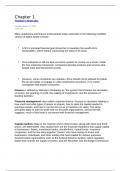Chapter 1
Teacher's Notes.doc
Monday, August 19, 2024
11:55 AM
Many academics and finance professionals today subscribe to the following modified
version of Adam Smith’s theory:
A firm’s principal financial goal should be to maximize the wealth of its
stockholders, which means maximizing the value of its stock.
Free enterprise is still the best economic system for society as a whole. Under
the free enterprise framework, companies develop products and services that
people want and that benefit society.
However, some constraints are needed—firms should not be allowed to pollute
the air and water, to engage in unfair employment practices, or to create
monopolies that exploit consumers.
Finance is defined by Webster’s Dictionary as “the system that includes the circulation
of money, the granting of credit, the making of investments, and the provision of
banking facilities.”
Financial management, also called corporate finance, focuses on decisions relating to
how much and what types of assets to acquire, how to raise the capital needed to
purchase assets, and how to run the firm so as to maximize its value. The same
principles apply to both for-profit and not-for-profit organizations, and as the title
suggests, much of this book is concerned with financial management.
Capital markets relate to the markets where interest rates, along with stock and bond
prices, are determined. Also studied here are the financial institutions that supply capital
to businesses. Banks, investment banks, stockbrokers, mutual funds, insurance
companies, and the like bring together “savers” who have money to invest and
businesses, individuals, and other entities that need capital for various purposes.
Governmental organizations such as the Federal Reserve System, which regulates
banks and controls the supply of money, and the Securities and Exchange Commission
, (SEC), which regulates the trading of stocks and bonds in public markets, are also
studied as part of capital markets.
Investments relate to decisions concerning stocks and bonds and include a number of
activities:
(1)
Security analysis deals with finding the proper values of individual securities (i.e., stocks
and bonds).
(2)
Portfolio theory deals with the best way to structure portfolios, or “baskets,” of stocks
and bonds. Rational investors want to hold diversified portfolios in order to limit risks, so
choosing a properly balanced portfolio is an important issue for any investor.
(3)
Market analysis deals with the issue of whether stock and bond markets at any given
time are “too high,” “too low,” or “about right.”
Included in market analysis is behavioral finance, where investor psychology is
examined in an effort to determine whether stock prices have been bid up to
unreasonable heights in a speculative bubble or driven down to unreasonable lows in a
fit of irrational pessimism.




